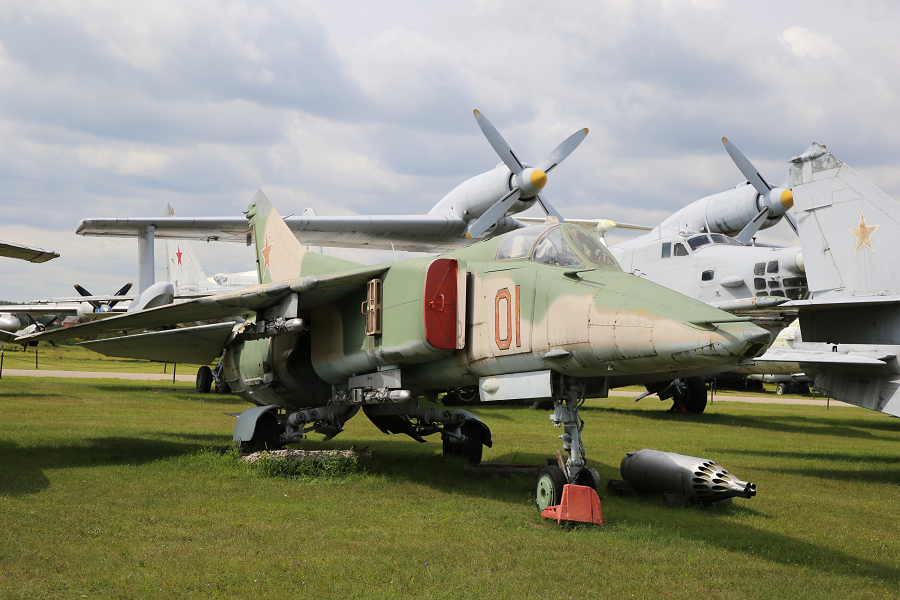MiG-27. A Soviet fighter-bomber from 1973.
The Mikoyan MiG-27 (NATO reporting name: Flogger-D/J) is a variable-sweep ground-attack aircraft, originally built by the Mikoyan-Gurevich design bureau in the Soviet Union and later licence-produced in India by Hindustan Aeronautics as the Bahadur (“Valiant”). It is based on the Mikoyan-Gurevich MiG-23 fighter aircraft, but optimised for air-to-ground attack.
Unlike the MiG-23, the MiG-27 did not have widespread use outside Russia, as most countries opted for the Mikoyan-Gurevich MiG-23BN and Sukhoi Su-22 instead. It remains in service only with the Kazakh Air Forces in the ground attack role. All Russian, Indian, Sri Lankan and Ukrainian MiG-27s have been retired.
The MiG-27 shares the basic airframe of the MiG-23, but with a revised nose – nicknamed “Utkonos” (“Platypus”) or “Krokodil Gena” in Russian service, first introduced on the MiG-23B. Dissatisfaction with the MiG-23BN led to the further development of the basic airframe to accommodate a stronger undercarriage, simpler intakes and a shorter exhaust nozzle, without radar in favor of a downward-sloping profile for improved pilot visibility,a laser rangefinder and marked-target seeker. Among its test pilots, it was also called “Balkon” (“Balcony”) because of the increased frontal view from the cockpit. Additional cockpit armor was installed, along with a totally new nav/attack system.
Since the MiG-27 was intended to fly most of its missions at low altitude, the MiG-23’s variable intake ramps and exhaust nozzles were discarded in favor of a simpler fixed configuration, reducing weight and maintenance requirements. The aircraft also has larger, heavy-duty landing gear to facilitate operation from poorer-quality airfields. In accordance with the MiG-27’s strike and low-level attack requirements, provisions were made to mount missiles and precision-guided munitions, as well as retaining a nuclear capability in line with other Soviet combat aircraft by introducing specialized navigation systems.
The improved MiG-27M/D versions were introduced during the 1980s, followed by the -K version, which could carry a much larger range of weapons including tactical nuclear bombs.
Aircraft deployed to Afghanistan were upgraded with the installation of BVP-50-60 flare dispensers and the NAZ-7B emergency survival kit, as well as engine modifications for the hot and high conditions.
The MiG-27 entered frontline service with Soviet Air Force Tactical Aviation in 1975, with the 722nd Regiment. It replaced earlier MiG-23B/BN and outdated Sukhoi Su-7 attack aircraft and equipped 22 of the 40 Soviet fighter-bomber regiments, being deployed all over the Soviet Union and other Warsaw Pact countries. Soviet MiG-27s were permanently deployed to five foreign countries: East Germany, Hungary, Poland, Czechoslovakia and Mongolia until the 1990s.
Flight range – 1810 km, max. speed – 1810 km/h, ceiling – 15600 m












